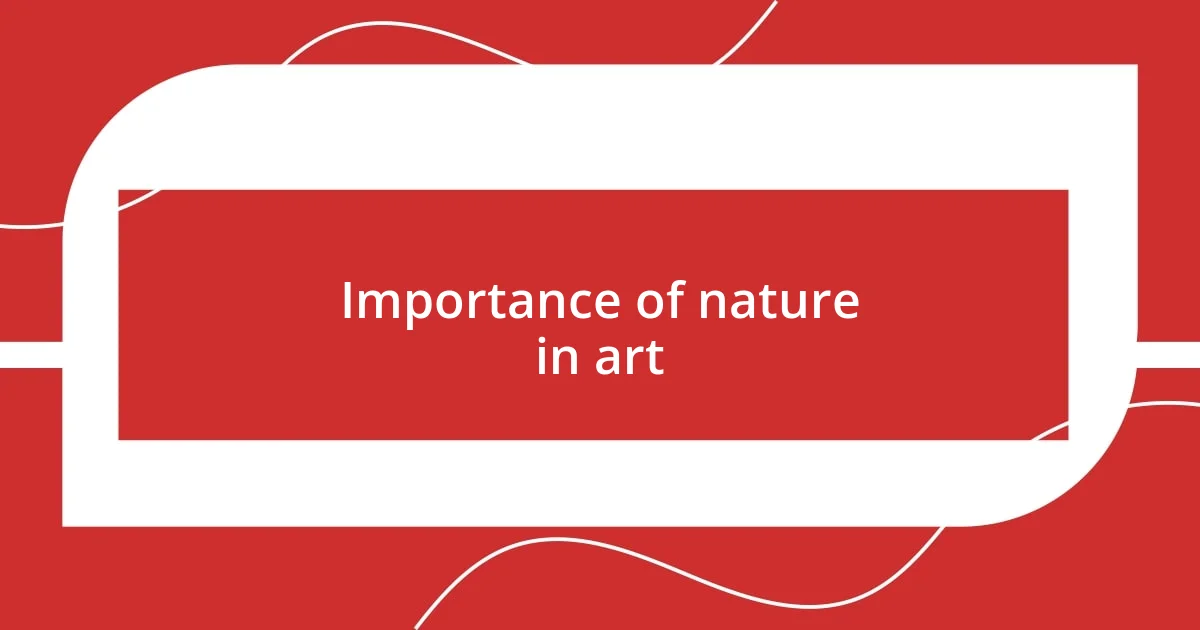Key takeaways:
- Nature is a primary inspiration, evoking emotional connections and storytelling in landscape paintings.
- Light and color play essential roles in shaping the atmosphere of artwork, reflecting the artist’s emotional state.
- Personal experiences and memories significantly influence an artist’s style and creative expression, allowing for deeper emotional resonance in their work.

Sources of artistic inspiration
Nature is a fundamental source of inspiration for my landscape paintings. I often find myself captivated by the subtle play of light on a forest floor or the vibrant colors of a sunset over the horizon. Have you ever stood outside, feeling the breeze and realizing how each element of nature tells its own story? Those moments compel me to capture the essence of those scenes on canvas.
Traveling has also dramatically influenced my art. Each new place I visit introduces me to different landscapes, cultures, and atmospheres. I remember a trip to the Scottish Highlands, where the dramatic cliffs and expansive lochs felt almost surreal. How could I not want to immortalize such breathtaking beauty? Each brushstroke echoes those unforgettable experiences, pulling the viewer into a world that is as much about emotion as it is about geography.
Lastly, the emotional states we experience can be incredibly powerful sources of creative fuel. I find that days when I’m feeling introspective often lead to more profound landscapes, portraying both serene and tumultuous elements. Have you noticed how emotions can shape the way you see the world? When I paint during these reflective times, it’s as if the canvas becomes a mirror, reflecting my inner landscape and inviting others to engage with those feelings.

Importance of nature in art
Nature in art holds tremendous importance as it often serves as the canvas upon which our emotions are painted. I’ve always found that when I immerse myself in natural surroundings, the experience transcends mere observation. For instance, while sketching by a tranquil lake one morning, I felt a profound connection to my surroundings. The gentle ripple of the water mirrored my own thoughts, and this harmony is something I strive to recreate in my work.
The interplay of nature and art also invites exploration of deeper themes. When I look at stormy skies, I see beauty in their chaos. This contrast is something I cherish – it reminds me of a time I stood on a cliff as waves crashed below, feeling both small and invincible. Capturing such moments in my paintings allows me to share not only the visuals but also the emotions they evoke. Isn’t it fascinating how a scene can stir feelings that words often fail to express?
Moreover, different environments can lead to unique artistic interpretations. For example, painting a sunflower field in full bloom transports me to a joyful place. In contrast, the rugged mountains invoke a sense of strength and resilience. Each piece created carries a piece of me, reflecting how nature’s diversity shapes our perceptions and emotions as artists. It’s a reminder that nature doesn’t just inspire art; it influences how we perceive our world.
| Aspect | Nature’s Impact |
|---|---|
| Emotional Connection | Nature often evokes profound feelings, reflecting inner states, such as calmness or chaos. |
| Inspirational Settings | Diverse landscapes provide unique perspectives that shape one’s artistic expression. |

Emotions conveyed through landscapes
The landscapes I paint are often more than just scenery; they are vessels of emotion that speak to the viewer. I recall a rainy afternoon when I stood under a canopy of trees, watching the droplets dance down the leaves. That moment encapsulated a sense of tranquility that I aimed to express in my work. When I create a painting of a misty forest or a sun-drenched meadow, I’m sharing a piece of that feeling, allowing others to experience the same peace—or perhaps evoke a sense of nostalgia or longing.
In my paintings, I strive to convey a variety of emotions through color, light, and composition. Here are a few examples:
- Joy: Bright, vibrant colors in a sunrise scene often spark feelings of optimism and renewal.
- Melancholy: A solitary tree on a hill during a twilight sky can evoke a sense of loneliness, stirring deep reflection.
- Calmness: Soft pastels and gentle brushstrokes in a serene lake scene may transport the viewer to a place of peace and quiet.
Through these emotional lenses, landscapes become compelling stories of our human experience, inviting viewers to find their own narratives within the scenes.

Techniques for capturing landscapes
Capturing landscapes requires a blend of observation and technique. I often begin by considering the composition of the scene. For instance, while painting a winding river, I take my time to note how it snakes through the landscape, drawing the eye towards the horizon. This approach not only brings dynamism to my work but also invites the viewer to journey alongside the river, enhancing their emotional connection to the piece.
Color selection plays a crucial role in conveying atmosphere. I remember one mesmerizing sunrise when the sky burst into shades of peach and lavender. This moment taught me that using a limited palette can amplify the mood of my painting, creating a vibrant contrast against the cool greens of the landscape. How do you think different colors affect your perception of a scene? I believe that thoughtful color choices can evoke specific feelings—whether it’s the warmth of morning light or the chill of twilight.
Brushwork and texture are the final touches that bring a landscape alive. I’ve found that using a palette knife for rocky surfaces creates a tactile quality that enhances the overall realism of the scene. It’s like inviting the viewer to feel the roughness of the stones beneath their fingertips. This method not only adds depth but also makes the painting resonate on a physical level. Have you ever touched a surface in a painting and felt the energy it conveys? For me, this tactile element is essential; it transforms a static image into an engaging experience that lingers in the mind and heart.

Influence of light and color
Light and color are the heartbeat of my landscape paintings. I often find myself captivated by the subtle changes in light throughout the day. For instance, while painting near a shimmering lake at dusk, I noticed how the golden hues danced upon the water’s surface. That fleeting moment reminded me of how light can transform a scene, making it feel both ephemeral and alive. Don’t you think moments like these inspire a deeper connection to nature?
The colors I choose are often influenced by my own emotional state. I recall a particularly challenging phase when I painted a foggy morning scene filled with muted blues and grays. The cool tones reflected my feelings of uncertainty and introspection, yet ultimately, the viewer found a sense of tranquility and mystery in that piece. I wonder how colors affect your mood? I’ve learned that soft, harmonious palettes often convey serenity, while bold, vibrant tones can energize and evoke joy.
Every painting becomes a dialogue between light and color, shaping the emotional landscape I aim to create. I once experimented with a sunset palette, layering reds, oranges, and purples, and felt a surge of excitement as the colors blended on the canvas. That burst of energy echoed the vibrant feelings we experience during such breathtaking moments in nature. Have you ever felt such a rush when witnessing a sunset? It reminds me that expressing these experiences through painting not only captures beauty but also encapsulates the emotions tied to those fleeting instances.

Personal experiences in landscape painting
Creating landscape paintings has been a deeply personal journey for me. One of my most memorable experiences was hiking up a hill just before dawn, the stillness of the pre-sunrise air enveloping me. As I reached the top, the sun broke free from the horizon, casting soft golden light over the valley below. That moment felt almost sacred, and I knew I had to capture it. Do you ever feel compelled to preserve a moment like that? For me, it was about more than just the view; it was about bottling the emotion of the scene—the tranquility, the hope of a new day.
I often reflect on the places that have resonated with me deeply. While visiting an ancient forest, I found myself drawn to the interplay of shadows and dappled sunlight through the leaves. The tall trees seemed to whisper secrets, inviting me to explore their stories through my brush. Each stroke was infused with a sense of wonder and reverence. Have you ever felt the embrace of nature like that? In those moments, my canvas transformed into a vessel holding not just a landscape but a piece of my spirit, reminding me of the beauty that exists beyond the chaos of daily life.
Sometimes, the emotional weight of a landscape can surprise me. I painted a windswept beach during a particularly tough time, the dark clouds reflecting my internal turmoil. As I smeared thick, grayish strokes across the canvas, I felt both an anger and catharsis building within me. This piece became a conversation—between my emotions and the natural world. What do you think happens when art mirrors our feelings? I believe that many times, through landscape painting, we can explore our complexities, find clarity, and ultimately connect to a deeper sense of self.

How to develop your style
Finding your unique style in landscape painting is a journey that often starts with exploration. I remember a time when I decided to step away from my usual coastal scenes and venture into the mountains. The raw, rugged beauty and the distant, misty silhouettes challenged me to play with texture and form. This shift in scenery sparked new ideas, and I found myself unraveling layers of my own creativity. Have you ever stepped outside your comfort zone, only to discover a part of yourself that you hadn’t realized was there?
As I continued to paint, I noticed that my style evolved alongside my personal experiences. During a road trip through vibrant autumn landscapes, I felt an overwhelming urge to capture the fiery colors of the leaves. I experimented with thick brushstrokes to convey movement, almost as if the trees were dancing in the wind. Those moments taught me that my style isn’t just about technical skill; it’s about tapping into emotions tied to the places I visit. How does your own environment influence your art?
Incorporating personal narratives into my work has become essential. I find that reflecting on memories while I paint enriches the process. One evening, I decided to reimagine a tranquil garden where I used to play as a child, infusing the scene with nostalgia and warmth. The soft, pastel colors I chose were reminiscent of those carefree days, and I could feel my heart lighten with each brushstroke. This made me wonder—how does your past shape your artistic voice? By embracing these experiences, I discovered that my style is not just a set of techniques but a heartfelt expression of who I am.















